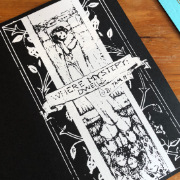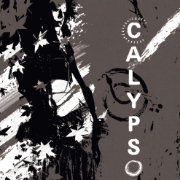Apocalypse World - Lady Blackbird Mashup

filed under game design on 12 Jan 2017
tagged lady blackbird, simple world, narrative, apocalypse world, and pbta
Update: a refined version is available here.
I’ve spent the last twelve days in head-cold-stomach-flu hell. Not much in the way of gaming going on, shared or solo. All projects on hold.
So the thing I was working on before I got sick? Combining Lady Blackbird and Apocalypse World, or more precisely, Simple World (a short, generic version of AW) because it’s very simple to understand and modify.
PbtA games expect a modifier between -1 and +3. So all we need to do is to figure out a way to get a modifier of roughly that range.
Here’s one way that utilizes Traits and Tags, which are pretty much my favorite way to define a character in solo play. I like being able to weave backstory into current abilities, and I like being able to make just about any character I can think of, as long as I can describe them in words.
So make a character as if for Lady Blackbird. Use The Blackbird Companion or roll your own. Don’t mark down reserve dice, we’re not using them. Try to avoid too much overlap in Tags, since the modifier will be capped at +3.
Take two long duration Conditions that reflect areas in which your hero is weak, like “Phobia” or “Bad Back” or “Gullible”. If this is your first session with this character, take a short duration Condition, too, like “Wounded” or “Tired” or “Hungry”, just to get the ball rolling.
Use Keys and Secrets as written. Choose if you want to use a Harm track/clock or Lady Blackbird style harm Conditions or a mix.
Building a Modifier
When a roll is called for, build a modifier.
Choose a Trait that applies, if any, and add one for it. Add one for each Tag under that Trait that applies.
The modifier can be no higher than +3 at this point. If it’s higher, it’s +3.
Add one for each Condition that helps and for any bonuses. Subtract one for each Condition that hinders. Any given Condition can only come into play once per roll; if a Condition already changes the roll in some way (by making you a target, say, or requiring or allowing the roll in the first place) it is not counted again now.
The modifier can no higher than +4 at this point; if it’s higher, reduce it to 4. If it’s lower than -1, you can opt to do something else, narratively, or roll anyway.
Now that you have a modifier, you could use AW (or another PbtA game) rules, letting the fiction trigger the moves and using them pretty much as written, gaining xp when those rules tell you to and spending them on both AW and Lady Blackbird advancements.
Or you can use the following “catchall move” (which is pretty heavily derived from Simple World but modified a bit for solo play).
Strive
When you want to achieve something but are opposed or success is not a given, first determine if any of your current Conditions affect the situation, then assemble a modifier as described as above and roll +modifier.
On a 10+, you succeed. Choose one as appropriate to the fiction: gain situational currency, lose a negative Condition, or gain a Condition or bonus on the next roll.
-
Situational Currency. Define something about the situation that may be purchased; either list 1d6 potential complications, outcomes, and hazards, or pick something the hero wants multiples of (like answers from a witness). Roll 1d6 and divide by 2, rounded up; you have this many points to spend. Example: 3 Interrogation Points, each worth an honest answer from the witness. 2 Victory Points, spend one to capture the villain, one to avoid any injury to your allies, one to stop the Doomsday device.
-
Gain a Condition or bonus. This can be ongoing or just to the next roll. Example: You have the Condition “High Ground” because you succeeded in gaining the high ground; add it to any roll where having the high ground would help, until you lose the high ground or leave it. Or you have a +1 to the next roll to intimidate a witness because you succeeded at roughing him.
On a 7-9, you succeed as if with 10+. Also establish a Complication, set up a soft move, or follow through on a previous soft move with a hard move. Or offer a hard bargain or make an ugly choice.
On a 6-, you fail. Deliver a new hard move out of the blue or follow through on a previous soft move with a hard move.
On a hard move, take a negative Condition, lose a positive Condition, take Harm, or lose something else important.
For a great explanation of hard and soft (“regular”) moves, look here.
Any time both dice show the same number, roll a random event that sets up a soft move.
And that’s all there is to it, really.


